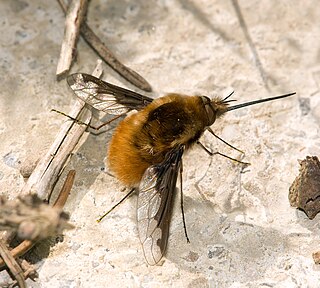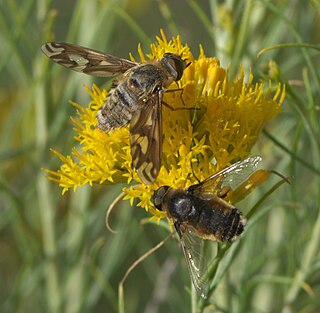
The Bombyliidae are a family of flies, commonly known as bee flies. Some are colloquially known as bomber flies. Adults generally feed on nectar and pollen, some being important pollinators. Larvae are mostly parasitoids of other insects.

Poecilanthrax willistonii, Williston's bee fly or sand dune bee fly, is a member of the Bombyliidae insect family. This family includes the bee flies, true flies that have developed Batesian mimicry characteristics to avoid predators. That is, they look like bees because that helps them avoid bee-wary predators, but they lack stingers.

Lepidophora lutea is a species of bee fly in the family Bombyliidae. It is found in Ontario and the eastern United States, from Maine and Florida west to Minnesota and Louisiana.

Lepidophora is a genus of bee flies in the family Bombyliidae. There are eight described species in Lepidophora.

Eclimini is a tribe of bee flies in the family Bombyliidae. This tribe was formerly considered a subfamily of Bombyliidae, but was transferred to the subfamily Bombyliinae as a result of research published in 2019.
Lepidophora vetusta is a species of bee fly in the family Bombyliidae. It is found in Texas, Mexico, and Central America as far south as Costa Rica.
Systropus angulatus is a species of bee fly in the family Bombyliidae. It is found in Texas.
Paravilla aridula is a species of bee fly in the family Bombyliidae. It is found in Arizona and California.
Hemipenthes inops is a species of bee fly in the family Bombyliidae. It is found in the western United States. It is somewhat unusual compared to other members of the genus Hemipenthes in that its wings are mostly transparent.
Lepidanthrax arnaudi is a species of bee fly in the family Bombyliidae. It is found in California.
Exoprosopa eremita is a species of bee fly in the family Bombyliidae. It occurs in western North America.
Paravilla tricellula is a species of bee fly in the family Bombyliidae. It is found in California.
Amphicosmus arizonicus is a species of bee fly in the family Bombyliidae. It is known from Arizona.
Lepidanthrax angulus is a species of bee fly in the family Bombyliidae. It is found in Mexico and the southwestern United States.
Poecilanthrax varius is a species of bee fly in the family Bombyliidae.
Paravilla fulvicoma is a species of bee fly in the family Bombyliidae. It is found in the western United States from Washington to Oklahoma, south into Mexico.

Toxophora amphitea is a species of bee fly in the family Bombyliidae. It is found in eastern North America from Ontario south to Florida and Texas.

Dipalta serpentina is a species of bee fly in the family Bombyliidae. It is widespread in North America from British Columbia, Canada south and east through most of the United States to Florida, Mexico, Cuba, Guatemala, and Honduras. It is a parasitoid of antlion species such as Myrmeleon immaculatus.
Exoprosopa clarki is a species of bee fly in the family Bombyliidae.
Hemipenthes edwardsii is a species of bee fly in the family Bombyliidae. It is found in the western United States and British Columbia, Canada.








